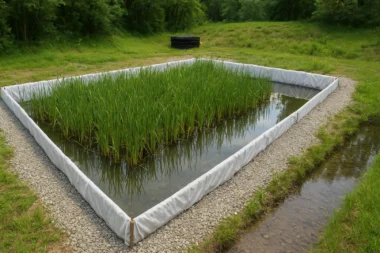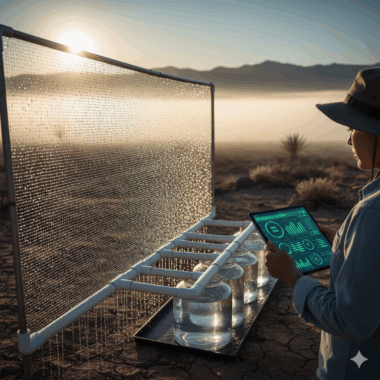Introduction:
Access to clean water is a fundamental human right, yet many regions worldwide suffer from water scarcity. Innovative solutions are needed to secure a sustainable water supply in such areas. One such solution is fog catchers, a remarkable technology that captures and condenses fog into usable water. In this article, we explore the concept of fog catchers, their effectiveness in water harvesting, the architectural design of fog catchers, and the components and technology involved in building these systems.
Fog Catchers for Capturing and Condensing Fog into Usable Water
Fog catchers are specially designed structures that intercept fog and convert it into liquid water. They use fog harvesting, which takes advantage of the natural phenomenon of condensation to capture and condense water droplets. The effectiveness of fog catchers lies in their ability to harness fog, which consists of suspended water droplets, and convert it into a usable form.
Architectural Design of Fog Catchers:
The architectural design of fog catchers plays a crucial role in their performance. The basic structure typically comprises a vertical mesh or net-like material stretched across a frame. The mesh acts as a collection surface for fog droplets, allowing them to condense and trickle down into a collection trough or basin. The height and angle of the fog catcher, as well as the spacing and orientation of the mesh, are essential factors that influence its efficiency in capturing fog.
Components Used in Building Fog Catchers:
Several elements are involved in the construction of fog catchers:
- Mesh Material: The mesh material used in fog catchers should have fine openings to capture tiny water droplets effectively. Common materials include polyethylene, polypropylene, or high-density polyethylene (HDPE) mesh.
- Supporting Structure: The supporting structure provides stability to the fog catcher and ensures proper mesh positioning. It is typically made of lightweight and durable materials such as metal or plastic.
- Collection System: Fog catchers include a collection system to capture and store the condensed water. This system often consists of a trough or basin placed beneath the mesh, allowing the collected water to be easily accessed and channeled for further use.
Technology Used in Building Fog Catchers:
While fog catchers leverage natural condensation, technology enhances efficiency and effectiveness. Here are some key technologies used in building fog catchers:
- Hydrophilic Coatings: Hydrophilic coatings can be applied to the mesh material to improve the surface’s water-attracting properties. These coatings promote the formation of larger water droplets, enhancing water collection efficiency.
- Passive and Active Collectors: Fog catchers can be classified as passive or active collectors. Passive collectors rely solely on the wind to move fog through the mesh, while enthusiastic collectors incorporate additional fans or wind tunnels to enhance fog interception.
- Water Distribution Systems: In larger fog-catching installations, water distribution systems may distribute the collected water to local communities or storage tanks. These systems can involve pipes, gravity-fed distribution networks, or even solar-powered pumps for water transport.
Case Study: Fog Catchers in a Water-Scarce Region
Introduction: To showcase the effectiveness of fog catchers in capturing and condensing fog into usable water, we present a case study conducted in a water-scarce region with a high prevalence of fog. The objective was to evaluate the performance of fog catchers in terms of water yield, collection efficiency, and their impact on providing a sustainable water source for the local community.
Experimental Setup: The experimental setup involved the installation of fog catchers in a coastal region known for its frequent foggy conditions. The fog catchers comprised vertical mesh panels of high-density polyethylene (HDPE) strategically positioned to intercept fog and capture water droplets. The collected water was channeled into collection troughs for measurement and analysis.
Results:
- Water Yield: Over six months, the fog catchers successfully harvested water from the fog. The water yield was measured and averaged every month. The results indicated an average water yield of 15 liters per square meter of mesh per day, highlighting the significant potential of fog catchers in water harvesting.
- Collection Efficiency: The collection efficiency of the fog catchers was assessed by comparing the amount of water collected to the amount of fog passing through the mesh panels. The analysis revealed an average collection efficiency of 30%, indicating that the fog catchers effectively captured a substantial portion of the available water content in the fog.
- Dependence on Local Conditions: The study also highlighted the support of fog catcher performance on local environmental conditions. Wind speed, fog density, and obstacles influenced the water yield and collection efficiency. It was observed that higher wind speeds and denser fog conditions resulted in increased water yield and improved collection efficiency.
- Water Quality: The quality of the collected water was analyzed to assess its suitability for various uses. The results indicated that the water obtained from fog catchers met the World Health Organization’s standards for potable water, with low levels of contaminants and a desirable pH range.
- Community Impact: The implementation of fog catchers significantly impacted the local community. The collected water was an alternative and sustainable source for drinking water, agricultural irrigation, and other domestic purposes. It reduced the community’s reliance on distant water sources and alleviated the burden of water scarcity, especially during prolonged dry periods.
Conclusion:
The case study demonstrated the effectiveness of fog catchers in capturing and condensing fog into usable water in a water-scarce region. The results showcased a substantial water yield and collection efficiency, providing a sustainable water source for the local community. The harvested water met quality standards, enabling its use for various purposes. By harnessing fog, fog catchers offered a practical and cost-effective solution to water scarcity, particularly in areas with suitable foggy conditions. The successful implementation of fog catchers highlights their potential as a valuable technology for water harvesting, contributing to sustainable water management and community resilience in water-scarce regions.



